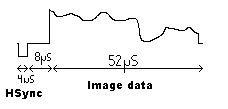

NTSC Basics
A television image is draw by an electron beam. This electron beam draws horizontal lines on the screen. It does this in two fields, an odd and even field which are interlaced to derive the final picture. The video signal that a TV receives controls the placement of the beam. NTSC is the standard way to generate television images in the United States.

|

|
A NTSC signal is generated by having 3 pre-equalization horizontal sync pulses, 3 vertical sync pulses, and 14 more horizontal sync pulses. No picture information should be outputted at these times. So then there are 242 frames left to display information in the manner shown above. Composite video signals need the following voltage levels:
|
A simple digital-to-analog converter can be used to output the appropriate values, as shown on our schematics page. Our scope output on the upper right for instance would output two white pixels for that particular horizontal scan line where the two peaks are. The valleys are hsyncs.
Hsync
Hsync is accomplished by driving the
video signal low for 4 us and then back up to black (0.3V) for 8 us.
Vsync is essentially an inverted hsync, except no picture information follows and vsync. A vsync tells the beam when to reset the beam and start drawing from the top again.

That is how NTSC TV signals work :).